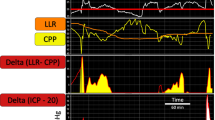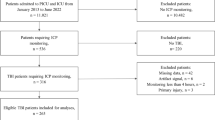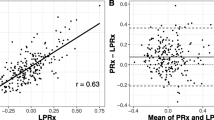Abstract
Introduction
Pressure-reactivity index (PRx) is a useful tool in brain monitoring of trauma patients, but the question remains about its critical values. Using our TBI database, we identified the thresholds for PRx and other monitored parameters that maximize the statistical difference between death/survival and favorable/unfavorable outcomes. We also investigated how these thresholds depend on clinical factors such as age, gender and initial GCS.
Methods
A total of 459 patients from our database were eligible. Tables of 2 × 2 format were created grouping patients according to survival/death or favorable/unfavorable outcomes and varying thresholds for PRx, ICP and CPP. Pearson’s chi square was calculated, and the thresholds returning the highest score were assumed to have the best discriminative value. The same procedure was repeated after division according to clinical factors.
Results
In all patients, we found that PRx had different thresholds for survival (0.25) and for favorable outcome (0.05). Thresholds of 70 mmHg for CPP and 22 mmHg for ICP were identified for both survival and favorable outcomes. The ICP threshold for favorable outcome was lower (18 mmHg) in females and patients older than 55 years. In logistic regression models, independent variables associating with mortality and unfavorable outcome were age, GCS, ICP and PRx.
Conclusion
The prognostic role of PRx is confirmed but with a lower threshold of 0.05 for favorable outcome than for survival (0.25). Results for ICP are in line with current guidelines. However, the lower value in elderly and in females suggests increased vulnerability to intracranial hypertension in these groups.





Similar content being viewed by others
References
Hyam JA, Welch CA, Harrison DA, Menon DK. Case mix, outcomes and comparison of risk prediction models for admissions to adult, general and specialist critical care units for head injury: a secondary analysis of the ICNARC Case Mix Programme Database. Crit Care. 2006;10:1–11.
Jennett B, MacMillan R. Epidemiology of head injury. Br Med J. 1981;282:101–4.
Steyerberg EW, Mushkudiani N, Perel P, et al. Predicting outcome after traumatic brain injury: development and international validation of prognostic scores based on admission characteristics. PLoS Med. 2008;5(8):e165, discussion e165.
Brain Trauma Foundation; American Association of Neurological Surgeons; Congress of Neurological Surgeons; Joint Section on Neurotrauma and Critical Care, AANS/CNS, Bratton SL, Chestnut RM, Ghajar J, et al. Guidelines for the management of severe traumatic brain injury. Introduction. J Neurotrauma. 2007;24 Suppl 1:S1–2.
Changaris DG, McGraw CP, Richardson JD, Garretson HD, Arpin EJ, Shields CB. Correlation of cerebral perfusion pressure and Glasgow Coma Scale to outcome. J Trauma. 1987;27:1007–13.
Narayan RK, Greenberg RP, Miller JD, et al. Improved confidence of outcome prediction in severe head injury. A comparative analysis of the clinical examination, multimodality evoked potentials, CT scanning, and intracranial pressure. J Neurosurg. 1981;54:751–62.
Brain Trauma Foundation; American Association of Neurological Surgeons; Congress of Neurological Surgeons; Joint Section on Neurotrauma and Critical Care, AANS/CNS, Bratton SL, Chestnut RM, Ghajar J, McConnell et al. Guidelines for the management of severe traumatic brain injury. VIII. Intracranial Pressure thresholds IX. Cerebral perfusion thresholds. J Neurotrauma. 2007;24 Suppl 1:S54–58 and S59–64.
Contant CF, Valadka AB, Gopinath SP, Hannay HJ, Robertson CS. Adult respiratory distress syndrome: a complication of induced hypertension after severe head injury. J Neurosurg. 2001;95:560–8.
Young JS, Blow O, Turrentine F, Claridge JA, Schulman A. Is there an upper limit of intracranial pressure in patients with severe head injury if cerebral perfusion pressure is maintained? Neurosurg Focus. 2003;15(6):E2.
Brady KM, Shaffner DH, Lee JK, et al. Continuous monitoring of cerebrovascular pressure reactivity after traumatic brain injury in children. Pediatrics. 2009;124(6):e1205–12.
Czosnyka M, Smielewski P, Kirkpatrick P, Laing RJ, Menon D, Pickard JD. Continuous assessment of the cerebral vasomotor reactivity in head injury. Neurosurgery. 1997;41(1):11–7.
Smielewski P, Czosnyka M, Steiner L, Belestri M, Piechnik S, Pickard JD. ICM+: software for on-line analysis of bedside monitoring data after severe head trauma. Acta Neurochir Suppl. 2005;95:43–9.
Patel HC, Menon DK, Tebbs S, Hawker R, Hutchinson PJ, Kirkpatrick PJ. Specialist neurocritical care and outcome from head injury. Intensive Care Med. 2002;28(5):547–53.
Helmy A, Vizcaychipi M, Gupta AK. Traumatic brain injury: intensive care management. Br J Anaesth. 2007;99(1):32–42.
Sorrentino E, Budohoski KP, Kasprowicz M, et al. Critical thresholds for transcranial Doppler indices of cerebral autoregulation in traumatic brain injury. Neurocrit Care. 2011;14(2):188–93.
Nordström CH, Reinstrup P, Xu W, Gärdenfors A, Ungerstedt U. Assessment of the lower limit for cerebral perfusion pressure in severe head injuries by bedside monitoring of regional energy metabolism. Anesthesiology. 2003;98(4):809–14.
Kiening KL, Unterberg AW, Bardt TF, Schneider GH, Lanksch WR. Monitoring of cerebral oxygenation in patients with severe head injuries: brain tissue PO2 versus jugular vein oxygen saturation. J Neurosurg. 1996;85(5):751–7.
Juul N, Morris GF, Marshall SB, Marshall LF. Intracranial hypertension and cerebral perfusion pressure: influence on neurological deterioration and outcome in severe head injury. The Executive Committee of the International Selfotel Trial. J Neurosurg. 2000;92(1):1–6.
Rosner MJ, Rosner SD, Johnson AH. Cerebral perfusion pressure: management protocol and clinical results. J Neurosurg. 1995;83(6):949–62.
Chan KH, Miller JD, Dearden NM. The effect of changes in cerebral perfusion pressure upon middle cerebral artery blood flow velocity and jugular bulb venous oxygen saturation after severe brain injury. J Neurosurg. 1992;77(1):55–61.
Vespa P, Prins M, Ronne-Engstrom E, et al. Increase in extracellular glutamate caused by reduced cerebral perfusion pressure and seizures after human traumatic brain injury: a microdialysis study. J Neurosurg. 1998;89(6):971–82.
Howells T, Elf K, Jones PA, et al. Pressure reactivity as a guide in the treatment of cerebral perfusion pressure in patients with brain trauma. J Neurosurg. 2005;102:311–7.
Steiner LA, Czosnyka M, Piechnik SK, et al. Continuous monitoring of cerebrovascular pressure reactivity allows determination of optimal cerebral perfusion pressure in patients with traumatic brain injury. Crit Care Med. 2002;30(4):733–8.
Menon DK. Procrustes, the traumatic penumbra, and perfusion pressure targets in closed head injury. Anesthesiology. 2003;98(4):805–7.
Vespa P. What is the optimal threshold for cerebral perfusion pressure following traumatic brain injury? Neurosurg Focus. 2003;15(6):E4.
Czosnyka M, Balestreri M, Steiner L, et al. Age, intracranial pressure, autoregulation, and outcome after brain trauma. J Neurosurg. 2005;102(3):450–4.
Czosnyka M, Radolovich D, Balestreri M, Lavinio M, et al. Gender-related differences in intracranial hypertension and outcome after traumatic brain injury. Acta Neurochir Suppl. 2008;102:25–8.
Balestreri M, Czosnyka M, Chatfield DA, et al. Predictive value of Glasgow Coma Scale after brain trauma: change in trend over the past ten years. J Neurol Neurosurg Psychiatry. 2004;75(1):161–2.
Castellani G, Zweifel C, Kim DJ, et al. Plateau waves in head injured patients requiring neurocritical care. Neurocrit Care. 2009;11(2):143–50.
Chambers IR, Treadwell L, Mendelow AD. Determination of threshold levels of cerebral perfusion pressure and intracranial pressure in severe head injury by using receiver-operating characteristic curves: an observational study in 291 patients. J Neurosurg. 2001;94(3):412–6.
Wang EC, Ang BT, Wong J, Lim J, Ng I. Characterization of cerebrovascular reactivity after craniectomy for acute brain injury. Br J Neurosurg. 2006;20(1):24–30.
Acknowledgments
The project was supported by the National Institute of Health Research, Biomedical Research Centre, Cambridge University Hospital Foundation Trust – Neurosciences Theme and Senior Investigator Awards (JDP, DKM), Technology Foresight Challenge Fund (Grant FCA 234/95), MRC Programme Grant (MRC G9439390). Clifford and Mary Corbridge Trust (KPB) and Foundation for Polish Science (MK). Many thanks to all colleagues participating in head injury monitoring program in Cambridge, UK in 1991-2009, whose experience, knowledge and clinical material helped us to write this study: Mrs. P. Al-Rawi, Mrs. D. Chattfield, Mrs. C.Turner, Dr. M. Balestreri, Miss. M.Hiler, Dr. SK Piechnik, Dr. LA Steiner, Mr. E. Guazzo, Mr. PC Whetfield, Mr. P. Minhas, Dr. M.Soehle, Mr. R. Kett-White, Dr. E. Schmidt, Mr. I. Timofeev, Mr. A.Helmy. Mr. PJ Kirkpatrick, Dr. B. Matta, Dr. J. Coles, Prof. A.Gupta, nursing and research staff from Neurosciences Critical Care Unit and Wolfson Brain Imaging Centre. Dr. M. Czosnyka is on leave from Warsaw University of Technology, Poland.
Author information
Authors and Affiliations
Corresponding author
Rights and permissions
About this article
Cite this article
Sorrentino, E., Diedler, J., Kasprowicz, M. et al. Critical Thresholds for Cerebrovascular Reactivity After Traumatic Brain Injury. Neurocrit Care 16, 258–266 (2012). https://doi.org/10.1007/s12028-011-9630-8
Published:
Issue Date:
DOI: https://doi.org/10.1007/s12028-011-9630-8




